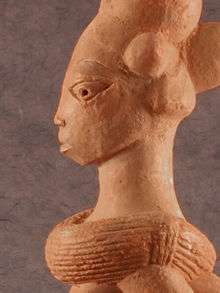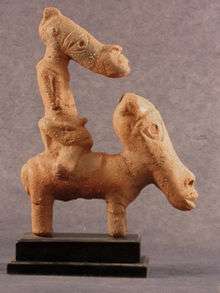Nok culture
The Nok culture is an early Iron Age population whose material remains are named after the Jaba village of Nok in Nigeria, Africa where their famous terracotta sculptures were first discovered in 1928. The Nok Culture appeared in Northern Nigeria around 1000 BCE and vanished under unknown circumstances around 500 CE in the region of West Africa lasting for about 1,500 years. It is thought to have been the product of an ancestral nation that branched to create the Hausa, Gwari, Birom, Kanuri, Nupe and Jukun peoples. The Kwatarkwashi Culture or Sokoto Culture located to the North west of Nok is thought to be the same as or an earlier ancestor of the Nok. [1]
 | |
| Geographical range | West Africa |
|---|---|
| Period | Iron Age |
| Dates | circa 1000 B.C.E. — circa 300 C.E. |
| Type site | Nok |
| Major sites | Samun Dukiya, Taruga, Jos |
| Followed by | Kwararafa |
Iron use, in smelting and forging for tools, appears in Nok culture in Africa at least by 550 BCE and possibly earlier. Christopher Ehret has suggested that iron smelting was independently discovered in the region prior to 1000 BCE.[2][3][4]


48 cm tall
Age: 900 to 1,500 years

53 cm tall
Age: 1,400 to 2,000 years
Part of a series on the |
|---|
| History of Northern Nigeria |
 |
|
Timeline
|
|
By ethnicity
|
|
By topic
|
|
By Province
|
Coordinates: 9°30′N 8°0′E / 9.500°N 8.000°E
Sculptures
Their function is still unknown, but scientific field work had started in 2005 to systematically investigate the archaeological sites and to understand these sculptures within their archaeological context.[5][6][7] For the most part, the terracotta is preserved in the form of scattered fragments. That is why Nok art is well known today only for the heads, both male and female, whose hairstyles are particularly detailed and refined. The statues are in fragments because the discoveries are usually made from alluvial mud, in terrain made by the erosion of water. The terracotta statues found there are hidden, rolled, polished, and broken. Rarely are works of great size conserved intact making them highly valued on the international art market.
The terracotta figures are hollow, coil built, nearly life sized human heads and bodies that are depicted with highly stylized features, abundant jewelry, and varied postures.
Little is known of the original function of the pieces, but theories include ancestor portrayal, grave markers, and charms to prevent crop failure, infertility, and illness. Also, based on the dome-shaped bases found on several figures, they could have been used as finials for the roofs of ancient structures.
Margaret Young-Sanchez, Associate Curator of Art of the Americas, Africa, and Oceania in The Cleveland Museum of Art, explains that most Nok ceramics were shaped by hand from coarse-grained clay and subtractively sculpted in a manner that suggests an influence from wood carving. After some drying, the sculptures were covered with slip and burnished to produce a smooth, glossy surface. The figures are hollow, with several openings to facilitate thorough drying and firing. The firing process most likely resembled that used today in Nigeria, in which the pieces are covered with grass, twigs, and leaves and burned for several hours.
In 1928, the first find was accidentally unearthed at a level of 24 feet in an alluvial tin mine in the vicinity of the village of Nok near the Jos Plateau region of Nigeria (Folorunso 32). As a result of natural erosion and deposition, Nok terracottas were scattered at various depths throughout the Sahel grasslands, causing difficulty in the dating and classification of the mysterious artifacts.
Luckily, two archaeological sites, Samun Dukiya and Taruga, were found containing Nok art that had remained unmoved. Radiocarbon and thermo-luminescence tests narrowed the sculptures’ age down to between 2,000 and 2,500 years ago, making them some of the oldest in West Africa. Many further dates were retrieved in the course of new archaeological excavations, extending the beginnings of the Nok tradition even further back in time.[8]
Because of the similarities between the two sites, archaeologist Graham Connah believes that "Nok artwork represents a style that was adopted by a range of iron-using farming societies of varying cultures, rather than being the diagnostic feature of a particular human group as has often been claimed."
Discovery
The Nok culture was discovered by Colonel Dent Young, a co-owner of a mining partnership near the village of Nok in 1928 on the Jos Plateau.[9] Young presented the sculptures to the museum of the Department of Mines in Jos.[10]
Fifteen years later, in 1943 near the village of Nok, in the center of Nigeria, a new series of clay figurines were discovered by accident while mining tin. A clerk in charge of the mine had found a head and had taken it back to his home for use as a scarecrow, a role that it filled (successfully) for a year in a yam field. This scarecrow was eventually noticed by Bernard Fagg who at the time was an administrative officer who had studied archaeology at the University of Cambridge. Fagg noticed that the head on the scarecrow looked similar to the sculpture that Young had found. He traveled to Jos where Young showed Fagg other recently uncovered terracotta figures. Eventually it became clear that the tin mining in Nok and Jema'a areas were revealing and destroying archaeological material. [11]
Preliminary archaeology
The preliminary excavation at the beginning of January 1961 began near a remote valley named Taruga near the village of Takushara. The trial excavations took place during a period of eight days. The finds included objects of wrought iron, a quantity of iron slag, fragments of tuyere, pottery, figurine fragments, red ocher, quartz hammer-stones, and small concentrations of charcoal. The most famous finds at the site were the pottery graters which were shallow, flat-bottomed dishes which were deeply scored inside with diced patterns to produce a sharp abrasive surface. These pottery graters were probably used for food preparation. In the preliminary excavation a proton magnetometer survey was used to try and locate furnaces. The survey revealed a total of 61 magnetic anomalies which were mostly located in a flat, central area which probably indicated the limits of actual occupation. Twenty of the anomalies revealed concentrations of slag and nine of them contained in situ structures of furnace walls and bases. The most common type of artefact found was domestic pottery which can be divided into two different types. One type are bowls or shallow basins without lips and the other are globular pots which have averted lips. Because of this preliminary excavation, the Nok Culture would start being regarded as belonging to the Iron Age.[12]
Looting and repatriation
In February 2013, Daily Trust reported that the Nigerian Ministry of Tourism, Culture, and National Orientation repossessed five Nok statuettes looted by a French thief in August 2010. The pieces had been seized by French customs agents, and were repatriated following a Nigerian government Directive. Antiquities analysts estimated the sculptures to be between 2,700 and 3,400 years old.[13]
See also
| Wikimedia Commons has media related to Nok culture. |
References
- ↑ Fagg, Bernard 1969 Recent work in west Africa: New light on the Nok culture. World Archaeology 1(1): 41–50.
- ↑ Jared Diamond, 'Guns, Germs, and Steel: The Fates of Human Societies' (1997) Chapter 19
- ↑ Duncan E. Miller and N.J. Van Der Merwe, 'Early Metal Working in Sub Saharan Africa' Journal of African History 35 (1994) 1-36
- ↑ Minze Stuiver and N.J. Van Der Merwe, 'Radiocarbon Chronology of the Iron Age in Sub-Saharan Africa' Current Anthropology 1968. Tylecote 1975 (see below)
- ↑ Breunig, P. (2014). Nok. African Sculpture in Archaeological Context. Frankfurt: Africa Magna.
- ↑ Breunig, P. (2013). Nok - Ein Ursprung afrikanischer Skulptur. Frankfurt: Africa Magna Verlag.
- ↑ Breunig, Peter, Kahlheber, Stefanie, and Rupp, Nicole. Exploring the Nok enigma. In: Antiquity Vol 82 Issue 316 June 2008
- ↑ Breunig, P. (2014). Nok. African Sculpture in Archaeological Context. Frankfurt: Africa Magna.
- ↑ Chesi, G. & Merzeder, G. (2006). The Nok Culture: Art in Nigeria 2500 Years Ago
- ↑ Shaw, Thurstan 1981 The Nok sculptures of Nigeria. Scientific American 244(2): 154–166.
- ↑ Shaw, Thurstan 1981 The Nok sculptures of Nigeria. Scientific American 244(2): 154–166.
- ↑ Fagg, Bernard 1969 Recent work in west Africa: New light on the Nok culture. World Archaeology 1(1): 41–50.
- ↑ Mustapha Suleiman (February 3, 2013), France Hands Over Stolen Nigerian Artifacts Daily Trust.
Further readings
- Atwood, R. (2011). The NOK of Nigeria. Archaeology July/August 2011, 34-38.
- Breunig, P. (ed.) (2014). Nok. African Sculpture in Archaeological Context. Frankfurt: Africa Magna Verlag.http://news.uwlax.edu/archeology-students-uncovering-passion/ ISBN 978-3-937248-46-2
- Breunig, P. & Rupp, N. (2006). Nichts als Kunst. Archäologische Forschungen zur früheisenzeitlichen Nok-Kultur in Zentral-Nigeria. Forschung Frankfurt 2-3, 73-76.
- Boullier, C.; A. Person; J.-F. Saliège & J. Polet (2001). Bilan chronologique de la culture Nok et nouvelle datations sur des sculptures. Afrique: Archéologie & Arts 2, 9-28.
- Fagg, A. (1972). A preliminary report on an occupation site in the Nok valley, Nigeria: Samun Dukiya, AF/70/1. West African Journal of Archaeology 2, 75-79.
- Fagg, B. (1959). The Nok Culture in prehistory. Journal of the Historical Society of Nigeria 1 (4), 288-293.
- Fagg, B. (1968). The Nok Culture: Excavations at Taruga. The West African Archaeological Newsletter 10, 27-30.
- Fagg, B. (1969). Recent work in West Africa: new light on the Nok Culture. World Archaeology 1 (1), 41-50.
- Fagg, B., (1990): Nok terracottas. Lagos: National Commission for Museums and Monuments.
- Jemkur, J. (1992). Aspects of the Nok Culture. Zaria.
- Rupp, N.; Ameje, J.; Breunig, P. (2005). New studies on the Nok Culture of Central Nigeria. Journal of African Archaeology 3, 2: 283-290.
- Rupp, N.; Breunig, P.; Kahlheber, S. (2008). Exploring the Nok enigma. Antiquity, Project gallery. Online publication: http://www.antiquity.ac.uk/ProjGall/kahlheber/index.html
- Shaw, T., (1981). The Nok sculptures of Nigeria. Scientific American 244(2): 154-166.
- Tylecote, R. (1975a). The origin of iron smelting in Africa. Westafrican Journal of Archaeology. 5, 1-9.
- Tylecote, R. (1975b). Iron smelting at Taruga, Nigeria. Journal of Historical Metallurgy 9 (2), 49-56.
- Olubunmi A.O.(2007) The Rise and Fall of The Yoruba Race, The 199 Publishing Palace ISBN 978-2457-38-8
- Olubunmi A.O.(2009) On Ijesa Racial Purity, The 199 Publishing Palace ISBN 978-2458-17-1
- Ayoade J.O.(1983) Introduction To Climatology For The Tropics, John Wiley & Sons ltd UK ISBN 0-471-10407-8
